Queen Cutlery Boxes in the 1990s
Fred Fisher, Brian Guth, Ashley and Joe Mick, and Dan Lago
In the 1990s, specifically 1991, things start to get very interesting as Queen Cutlery re-introduced the Schatt & Morgan branded knives, using older machines, tooling and dies, materials stored in their factory dating from 1903, and skill they had acquired from several significant contracts with other major knife companies. The success of this purely collector line produced many changes in boxes, and many new knives for collectors interested in Queen Cutlery.
Queen Labeled boxes
We do not know exactly the date Queen shifted to two-piece heavy cardboard boxes with the “Q knife” logo from the ’80s, but updated with “Queen Steel” in script lettering. These boxes had printed labels and were provided in two versions; black script on white, or white script on black in large and small pocket and fixed blade sizes. Probably around 1991, would be a reasonable estimate.
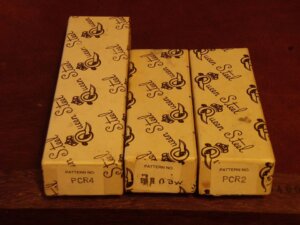
Figure 1. Queen-labeled knives were shipped in these heavy cardboard boxes throughout the 1990s and show pre-printed labels. “PCR” is for painted Crown red, 4 is swing guard Lock, and 2 is Doctor’s knife; Very specific boxes for the knife enclosed.
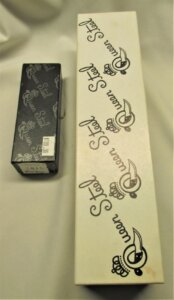
Figure 2. Queen boxes for both Fixed blade and pocket knives were used in both black printing on white and reverse white on black printing. As with other inventory, boxes were also used right up till the factory closed. An example is the black box in Figure 2, which was for a 19L liner lock in blue bone, issued only in 2016, and bought directly from the Titusville factory, clearly demonstrating use of existing inventory.
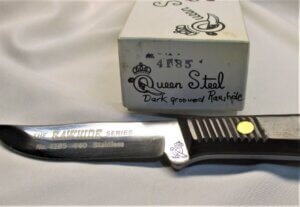
Figure 3. Handwritten notes (by collectors) can be quite useful if they conform with the knife inside the box. Many times, the model # for the knife is correct (in this case, fixed blade premium saber #4185), but handle materials started changing rapidly and are not necessarily included on the pre-printed label. So, in this case, the handwriting for “dark grooved Rawhide” (produced in 1995 in the last days of Rawhide is helpful.
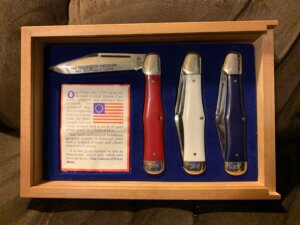
Figure 4. 1992 set called “The Colors of Freedom,” with three single-blade large coke bottles using a wooden box specifically for the knives. They use the Queen tang stamp, with smooth red, white and blue acrylic handles, It was not produced in as large an edition (estimated @500 units) as the patriotic bicentennial daddy barlow (of 1976) and is much harder to find. Each knife is serialized with the same number on the lower bolster and the set is in a display case with a clear slide-out top for easy access.
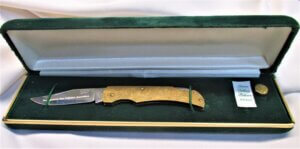
Figure 5. A small (#8445) “Executive” series lockback produced by Queen in 1998, as an SFO for the “Pennsylvania Gun Collectors Association” was offered in a dark green velvet clamshell box, with a very cute tie tack made from a Queen incised shield. Some other SFO knives were similarly packaged in black velvet clamshell boxes.
Schatt & Morgan Boxes

Figure 6. The traditional Schatt & Morgan knife box used from 1991 till 2017, is a two-piece box in deep brown with an exact copy of an early Schatt & Morgan label. These boxes are prone to damage to their brown finish and to all sorts of unusual markings on their labels – some from the factory and some from years of use among collectors. If possible, it is best if the unaltered label matches the knife inside! These two examples show a pure white label (left) and one with an “eggshell” color (right). Both are correct, and usually with the “eggshell” color thought to be earlier.
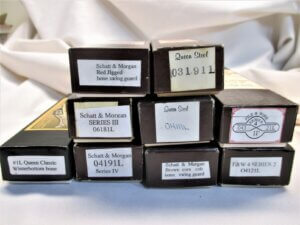
Figure 7. Labels for 1L swing guard Lockbacks (mostly) in the 1990s. You can see more care in describing the knife and series on the pre-printed labels. Still, in the very productive early 1990s, you see two handwritten “special project” labels for limited edition swing guards. Two clearly labeled boxes for “File and Wire” knives are also shown on the far right. The “Queen Classic” box on the far left (dated 2002) shows similar attention to the pre-printed label, even though those were offered in very small editions (An SFO offering).
Private label knives, largely from knife collector clubs, bearing Schatt & Morgan markings, were usually boxed in the familiar brown box and usually contained a label with sponsor, year, and knife model. It has been estimated that contract knives for other companies may have been up to 50% of all the knives that Queen produced during these very good years. But, of course with other company’s tang marks and decisions about what if any box or container was used, there is no good way to characterize knives in this category.
Display Boxes in the Schatt & Morgan Keystone Series
The definitive published article on the Schatt & Morgan Keystone series knives was by David Krauss (2010), in Knife World where he summarizes the history behind the series, every annual edition in a detailed table, as well as showing many examples of the quality of these knives. This article is the first to describe variations in display boxes for this series.
Oak boxes (12″ wide x 18″ long and 2″ deep), with brass hinges and a lock, were provided for display of the six or seven knives in each year if a person bought the entire set at one time, from the first year 1991, through 2010. The display boxes, while included if the whole set was purchased were not described at all throughout the 1990s – the first mention of the box in sales fliers was in 2000 (see discussion in the “box article for 2000-2012”).
The display boxes were not labeled for year or with the company name. Some boxes were etched or painted with the company name and logo, while the earliest had just clear glass. Gradually, the company shifted from Oak to Cherry and finally to Walnut by the 21st century. So, Queen was not very consistent with display boxes over the 20 years of this series.
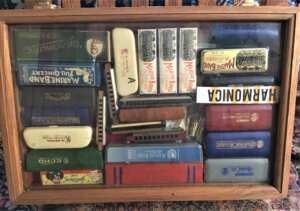
Figure 8. A Queen Cutlery Schatt & Morgan Keystone display box (apparently in Oak), bought new from the factory in the first years of the Keystone Series – but NO identification of the company or year. In this case, the original owner bought the complete set, but “repurposed” the box because his knives were always stored away from sunlight and humidity, so he chose to display his collection of vintage harps and harmonica boxes.
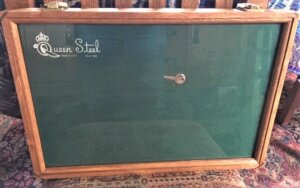
Figure 9. An oak wooden display box provided with a complete set for Schatt and Morgan annual Keystone Knives in the late 1990’s, this time with painted label. While the color of the felt backing changes yearly, there is no record of those changes to date a display box at this time.
While available records do not distinguish sales data for individual knives as compared to complete sets, it is clear that the large majority were not sold as a whole set with display box. Some knives in each series were much more desirable to collectors, compared to an entire series. The display boxes are not all that common. Many collectors kept their Keystone knives in the usual brown Schatt and Morgan carboard boxes and sold their knives on the secondary market in the same way to increase their profit.
Further, because the boxes were large for the number of knives, to permit “blade open” display, they were often used to display larger numbers of knives (or other collectables -such as Figure 8!) and are retained by owners after the Keystone knives are sold to display other knives. Therefore, these early boxes are frequently separated from the original knives that went with it.
These 199os display boxes might increase the value of the knives in a particular set, if the new owner was interested in display. They represent an early experience with display boxes by Queen Cutlery. Certainly, those like Figure 9, with a company logo will bring a premium in the collector market. And especially in the 2000s, where box and knives belong can be tied to a specific year and have been kept together will be greatly valued by future collectors.
References
Krauss, David, A. Ph.D, (2010). Schatt & Morgan Sets, 1991-2010. Knife
World, p. 1, Vol. 36,7, July. Knife World Publications. P.O. Box 37927,
Knoxville, TN,
We gratefully acknowledge the information and several photographs from David Krauss in completing this paper.

![Figure 2[81] Queen Box for Fixed Blade and Pocket Knife 1990s](https://queencutleryguide.com/wp-content/uploads/elementor/thumbs/Figure-281-q075li5mpsjrn3i0s04ao5ukgpg6znxfqkzvwlq9oo.jpg)

